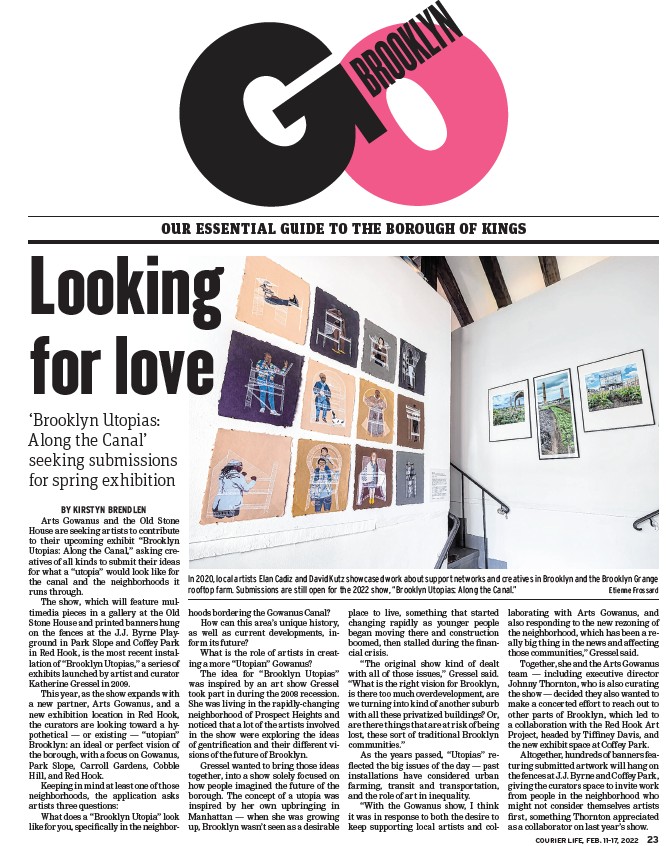
In 2020, local artists Elan Cadiz and David Kutz showcased work about support networks and creatives in Brooklyn and the Brooklyn Grange
rooftop farm. Submissions are still open for the 2022 show, “Brooklyn Utopias: Along the Canal.” Etienne Frossard
COURIER LIFE, FEB. 11–17, 2022 23
OUR ESSENTIAL GUIDE TO THE BOROUGH OF KINGS
BY KIRSTYN BRENDLEN
Arts Gowanus and the Old Stone
House are seeking artists to contribute
to their upcoming exhibit “Brooklyn
Utopias: Along the Canal,” asking creatives
of all kinds to submit their ideas
for what a “utopia” would look like for
the canal and the neighborhoods it
runs through.
The show, which will feature multimedia
pieces in a gallery at the Old
Stone House and printed banners hung
on the fences at the J.J. Byrne Playground
in Park Slope and Coffey Park
in Red Hook, is the most recent installation
of “Brooklyn Utopias,” a series of
exhibits launched by artist and curator
Katherine Gressel in 2009.
This year, as the show expands with
a new partner, Arts Gowanus, and a
new exhibition location in Red Hook,
the curators are looking toward a hypothetical
— or existing — “utopian”
Brooklyn: an ideal or perfect vision of
the borough, with a focus on Gowanus,
Park Slope, Carroll Gardens, Cobble
Hill, and Red Hook.
Keeping in mind at least one of those
neighborhoods, the application asks
artists three questions:
What does a “Brooklyn Utopia” look
like for you, specifi cally in the neighborhoods
bordering the Gowanus Canal?
How can this area’s unique history,
as well as current developments, inform
its future?
What is the role of artists in creating
a more “Utopian” Gowanus?
The idea for “Brooklyn Utopias”
was inspired by an art show Gressel
took part in during the 2008 recession.
She was living in the rapidly-changing
neighborhood of Prospect Heights and
noticed that a lot of the artists involved
in the show were exploring the ideas
of gentrifi cation and their different visions
of the future of Brooklyn.
Gressel wanted to bring those ideas
together, into a show solely focused on
how people imagined the future of the
borough. The concept of a utopia was
inspired by her own upbringing in
Manhattan — when she was growing
up, Brooklyn wasn’t seen as a desirable
place to live, something that started
changing rapidly as younger people
began moving there and construction
boomed, then stalled during the fi nancial
crisis.
“The original show kind of dealt
with all of those issues,” Gressel said.
“What is the right vision for Brooklyn,
is there too much overdevelopment, are
we turning into kind of another suburb
with all these privatized buildings? Or,
are there things that are at risk of being
lost, these sort of traditional Brooklyn
communities.”
As the years passed, “Utopias” refl
ected the big issues of the day — past
installations have considered urban
farming, transit and transportation,
and the role of art in inequality.
“With the Gowanus show, I think
it was in response to both the desire to
keep supporting local artists and collaborating
with Arts Gowanus, and
also responding to the new rezoning of
the neighborhood, which has been a really
big thing in the news and affecting
those communities,” Gressel said.
Together, she and the Arts Gowanus
team — including executive director
Johnny Thornton, who is also curating
the show — decided they also wanted to
make a concerted effort to reach out to
other parts of Brooklyn, which led to
a collaboration with the Red Hook Art
Project, headed by Tiffi ney Davis, and
the new exhibit space at Coffey Park.
Altogether, hundreds of banners featuring
submitted artwork will hang on
the fences at J.J. Byrne and Coffey Park,
giving the curators space to invite work
from people in the neighborhood who
might not consider themselves artists
fi rst, something Thornton appreciated
as a collaborator on last year’s show.
Looking
for love
‘Brooklyn Utopias:
Along the Canal’
seeking submissions
for spring exhibition